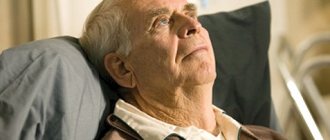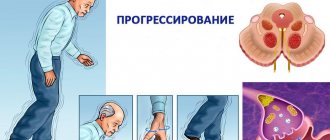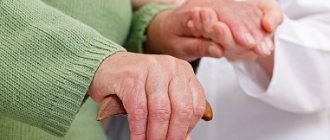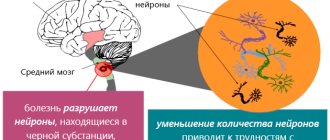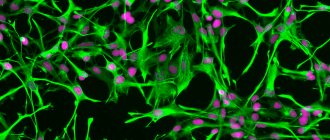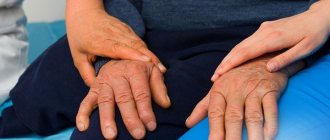Parkinson's disease mainly affects older people. The disease develops due to a lack of the neurotransmitter dopamine. It occurs in 120–180 people per 100 thousand population. The disease progresses steadily and leads to disability. Neurologists at the Yusupov Hospital use modern methods of treating Parkinson's disease, which can reduce the severity of symptoms and improve the quality of life of patients.
Initial manifestations of the disease
Between 5 and 10% of all cases of Parkinson's disease have a direct monogenic basis. Currently, more than fifteen genes for hereditary forms of primary parkinsonism have been identified.
The remaining cases are sporadic and occur under the influence of several factors. The sporadic form of the disease develops as a result of the influence of genetic and environmental factors. This determines the characteristics of cellular detoxification and xenobiotic metabolism, processing of a number of neuronal proteins, antioxidant protection, and the nature of dopamine metabolism.
An obligatory sign of the disease is hypokinesia, i.e. slowness, awkwardness of movements, impoverishment of the motor pattern, while muscle strength remains intact throughout the disease. The patient experiences some difficulties when performing the following basic everyday activities:
- tying shoelaces;
- fastening buttons
- shaving
- use of cutlery
- sticking one's hand into one's sleeve
- writing difficulties: handwriting becomes small (micrography)
- acheirokinesis: loss of friendly movement of the affected arm when walking
Doctors often encounter advanced stages of the disease in practice, because most people associate Parkinson’s disease with tremor, which is not at all necessary for Parkinson’s disease, while patients ignore other symptoms of the disease or attribute them to diseases of the joints or muscles.
Neurologists distinguish four components of akinesia:
- violation of motor initiative;
- violation of motor learning strategy;
- violation of the kinetic “melody”;
- When performing repeated tasks, there is a gradual attenuation of the amplitude of movements.
If tremor is present at the onset of the disease, then it is necessarily one-sided, like other signs of the disease; classic tremor in Parkinson’s disease is observed in a resting limb, intensifies when walking, but when performing movements of the affected limb, the tremor disappears. This type of tremor is not unique to Parkinson's disease, but its presence almost always indicates Parkinson's disease. It should be noted that Parkinson's disease never begins with a shaking head.
The following symptoms are characteristic of Parkinson's disease:
- hypokinesia;
- rest tremor;
- plastic muscle rigidity;
- postural instability.
Postural instability occurs at a more advanced stage of the disease.
Hypokinesia is detected clinically with a number of voluntary movements:
- the patient freezes in various positions, sometimes resembling a mannequin (not to be confused with true “freezes”, as complications of levodopa therapy);
- he has difficulty changing body position and initiating movement;
- there is no emotional coloring on the face (hypomimia), the patient rarely blinks;
- speech becomes monotonous, quiet, poorly modulated, gradually fading, and acquires a “tremor” character;
- hypophonia develops (decreased speech volume); bradyllia (slowness of speech), dysprosody (loss of melody in speech).
For early detection of hypokinesia, doctors at the Yusupov Hospital use the following tests:
- Fournier test. The patient is asked to perform a series of movements as quickly as possible: stand up, sit down, bend over, turn around, bend over. Slowness of movements is possible at the initial stage of hypokinesia;
- tapping test with thumb and index finger. The patient alternately taps on the table with both hands with the index and thumb at the maximum possible pace and with maximum amplitude. When hemiparkinsonism develops, one hand lags behind the pace and amplitude of the other hand, which is not yet involved in the disease;
- test of squeezing and unclenching the hand: the doctor asks the patient to clench and unclench the hand as quickly as possible (on the side of developing hypokinesia, the hand lags behind).
- Toe tap test
- Test with tapping the heel on the floor, in both cases an asymmetry of symptoms is visible.
Muscle rigidity, or plastic hypertonus, is a plastic increase in muscle tone. It increases in the initial phase of the movement and remains until the end of the movement. During a neurological examination, doctors often find the Negro phenomenon (the “gear wheel” symptom): against the background of plastic hypertonicity, a feeling of intermittency, step-by-step muscle resistance appears, and the tone increases with passive alternating movements.
Due to increased muscle tone, which predominates in the flexor muscles of the torso, the patient develops a peculiar “petitioner” pose: his head is lowered, his legs and arms are bent at the knee and elbow joints, and his feet take a parallel position to each other. By the way, forward tilt of the body, along with resting tremor and acheirokinesis, greatly facilitate the clinical diagnosis of Parkinson's disease. After raising the patient's head above the pillow, it remains in this position for some time. When performing the pendulum leg swing test, limb movements stop immediately after the test is completed.
Memory tests
The simplest method for identifying memory impairment is the “5 words” test. The patient is given a sheet of paper on which 5 simple words from everyday vocabulary are written. After reading, the test taker must reproduce them. Then the patient is distracted by a conversation for 3-4 minutes and again asked to repeat the previously read words. If it is impossible to reproduce them immediately after reading, they speak of severe memory impairment, in other cases - of mild or moderate degree.
Another way to assess memory and memorization ability is a questionnaire test. The method is less informative because the testing does not exclude a subjective factor (a person may provide unreliable information). This test is suitable not only for the patient with Parkinson's disease, but also for his close relatives. Memory impairment is indicated when the answer is positive two or more times. The Parkinson's test consists of the following questions:
- Over the last month, have you forgotten to turn off the gas, iron or water?
- Have you lost things in the last month? If yes, how many times?
- Have you ever thought that a close relative looks completely different and you don’t recognize him?
- Do you have difficulty remembering a phone number or a date?
- Do you feel confused in a previously familiar area or area?
Another simple method for identifying the disease and concomitant mental disorders is the date recall test. The patient is asked to say when he or his immediate family was born. Long thinking, inability to answer a question, or ridiculous answers (for example, 03/45/1173) are an unfavorable sign.
Non-motor manifestations of Parkinson's disease
Parkinson's disease has a whole range of non-motor manifestations that occur in all patients, regardless of the stage of the disease and age of onset:
- neuropsychiatric disorders (emotional, cognitive, behavioral, psychotic);
- sleep and wakefulness disorders;
- sensory disturbances (tingling, goosebumps) and pain;
- autonomic disorders (a very wide range of disorders among which the most maladaptive are frequent urge to urinate and orthostatic hypothesis, and the most common symptom is constipation);
- increased fatigue.
Before the onset of classic motor disorders in Parkinson's disease, non-motor manifestations may appear:
- constipation;
- impaired sense of smell;
- sleep disorders;
- pain syndromes.
In this regard, neurologists currently distinguish the preclinical, premotor stage of Parkinson's disease.
Tests to assess attention and thinking
A quick way to identify disorders of thinking and intelligence are mathematical problems. The patient is asked to solve examples with simple arithmetic operations (addition, subtraction, multiplication). The second stage of testing is counting backwards with subtracting the number 7. The test taker must subtract 7 from a given number (usually 100 or 1000), then name the resulting difference. The arithmetic operation is performed at least three times.
Important! The inability to perform basic arithmetic operations is a sign of severe impairment of intelligence and thinking.
Another cognitive (thinking) test for Parkinson's can be done at home. To do this, the patient is told two words that are related in meaning (for example, cat and dog). The test taker must explain what the relationship is between these words. Not only is the absence of a solution considered incorrect, but also answers based on secondary features (for example, “a cat and a dog have a tail” or “an orange and a banana have a peel”).
An accessible method for identifying attention disorders is a digital test. During this procedure, the patient is told 5 numbers from the top ten at a rate of 1 number per second. The test taker must repeat the numbers in forward and reverse order. You can also use graphic cards to assess attention. 10 images are laid out in front of the patient and given 60 seconds to memorize. The test taker is then asked to turn away and one of the cards is removed. The patient must determine which image is missing.
Causes
The exact causes of Parkinson's disease have not been identified. Scientists have been able to identify only a number of factors that increase the risk of developing neurodegenerative processes:
- natural processes of aging of the body, accompanied by a decrease in the ability of tissues to regenerate;
- genetic predisposition (this is especially true for forms with early onset);
- chronic lack of vitamin D, which protects neurons from the pathological effects of toxins;
- intoxication with salts of heavy metals, pesticides, alcohol;
- poor environmental conditions in the region of residence;
- taking certain medications (for example, chlorpromazine);
- chronic insufficiency of blood supply to the brain (due to atherosclerosis, osteochondrosis of the cervical spine, etc.);
- infections affecting the central and peripheral nervous system (meningitis, encephalitis, herpes viruses, influenza);
- brain tumors;
- traumatic brain injuries;
- smoking;
- frequent and prolonged stress, chronic fatigue.
Make an appointment
Treatment of pathology
Treatment strategies for Parkinson's disease depend on the stage at which the patient begins receiving the necessary therapy. For this reason, neurologists prefer to separate therapeutic approaches aimed at relieving early and late symptoms.
Treatment in the early stages involves the use of medications that stimulate the synthesis of dopamine in the brain. The therapeutic effect is achieved by stimulating dopamine releases and blocking reuptake. Thanks to this, it is possible to reduce the rate of neuronal death. Basic drugs can be used as part of complex treatment or as monotherapy. The combination of necessary substances is selected by a neurologist based on the clinical picture of parkinsonism and the individual characteristics of the patients.
Treatment of Parkinson's disease in the later stages remains an inevitable stage, since drug therapy can only slow down destructive processes. Progressive pathology is complemented by new symptoms that are difficult to relieve. At a certain point, the usual effectiveness of medications decreases. The patient experiences hypersensitivity of dopamine receptors and a kind of withdrawal syndrome due to the body's resistance to substances taken for a long time.
Against this background, doctors are forced to prescribe constantly increasing doses of medications to patients by reducing the intervals between doses. An alternative solution is to switch to a combination treatment regimen, which uses drugs from several groups. In some cases, surgery may be possible to implant an electrode into the patient that provides deep brain stimulation. This method allows you to stop resting tremor and restore motor activity in people suffering from Parkinson's disease.
Diagnostics
The diagnosis of Parkinson's disease is made based on the characteristic clinical picture. The patient is examined by a neurologist who notes typical signs. Complaints must be clarified and an anamnesis of the disease (history of the appearance of symptoms) and life history (information about previous injuries, chronic diseases, surgical interventions) is collected. Laboratory and instrumental diagnostics are used to clarify concomitant pathology and exclude other causes of neurological disorders.




